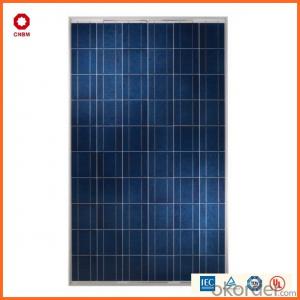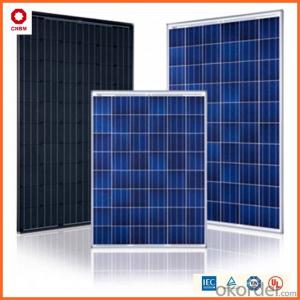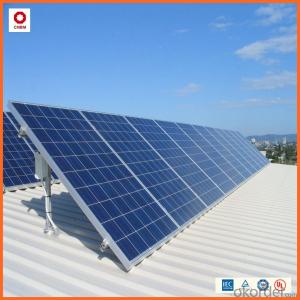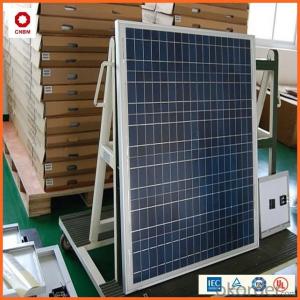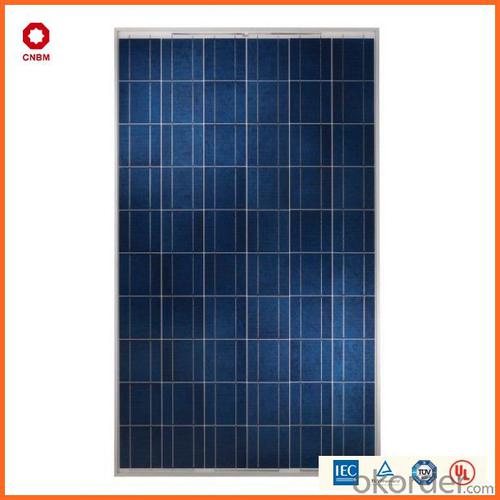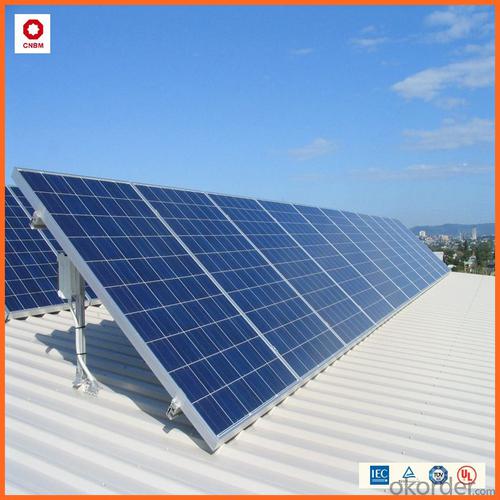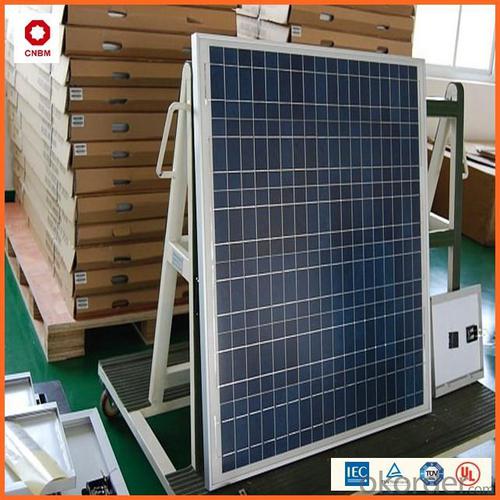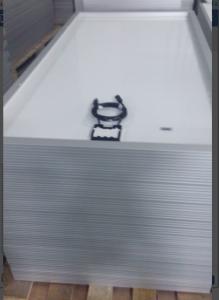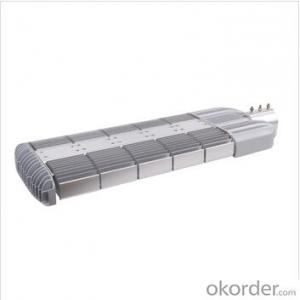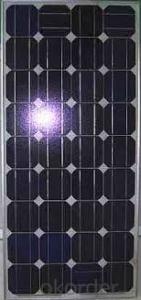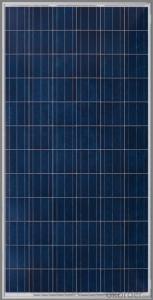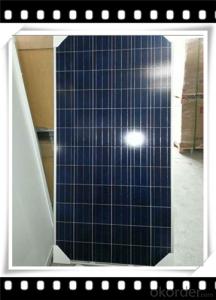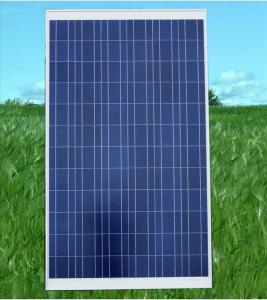Water Cooled Solar Panels - China Manufacture 185W-295W Poly Solar Panel from CNBM
- Loading Port:
- China main port
- Payment Terms:
- TT OR LC
- Min Order Qty:
- 1000 watt
- Supply Capability:
- 1000000 watt/month
OKorder Service Pledge
OKorder Financial Service
You Might Also Like
A Grade 185w-315w high efficiency Poly PV Solar panels -pv modules
Packaging & Delivery
Packaging Details: 25PCS/Pallet, carton box with wooden pallet or wooden box with pallet
Delivery Detail: 7-15 days according to the order quantity
Product Description
Max Power Voltage Vmp(V) | 31.5 |
Max Power Current Lamp(A) | 7.94 |
Open Circuit Voltage Voc(V) | 37.5 |
Short Circuit Current Isc(A) | 8.72 |
Temperature Coefficients of Isc (%/℃) | 0.0825 |
Temperature Coefficients of Voc (%/℃) | -0.4049 |
Temperature Coefficients of Pmp (%/℃) | -0.4346 |
Max Power(w) | 250 |
We now provide
• Monocrystalline Solar Panel
• Polycrystalline Solar Panel( multicrystalline silicon Solar Panel)
Features of our products:
• High conversion efficiency mono/poly-crystalline amorphous silicon solar cells
• Modules incorporate high performance bypass diodes to minimize the power drop caused by shading
• High transmittance, low-iron tempered glass
• High performance EVA encapsulant to prevent destroying and water.
• AI frame: without screw, corner connection. 8 holes on the frame can be installed easily
• Good performance of preventing from atrocious weather such as wind and hails
Limited Product Warranty
Under normal application, installation, use and service conditions, if MODULES fail to conform to this limited product warranty due to defects in material or workmanship, then for a period ending 12 years from date of sale as shown in the invoice or Contract issued by CNBM SOLAR. CNBM SOLAR will, at its option, either repair or replace or refund the purchase price as paid by the client for these defective MODULES. The repair or replacement or refund remedy shall be the sole and exclusive remedy provided under the “Limited Product Warranty” and shall not extend beyond the 12 years period set forth herein. It will be performed directly to the direct client only. This “Limited Product Warranty” does not warrant a specific power output, which shall be exclusively covered under “Limited Peak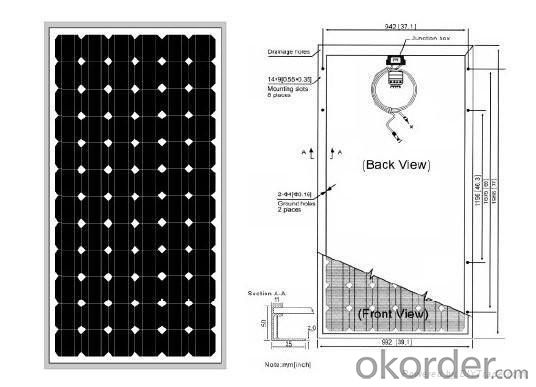
Company Profile
China National Building Material (CNBM) Group Corporation

CNBM Solar photovoltaic (PV) Panel is designed for large electrical power requirements. It is the optimal choice for both on-grid and off-grid power systems. CNBM Solar panel offers high performance of power per square foot of solar array. Monocrystalline silicon(c-Si): often made using the Czochralski process. Single-crystal wafer cells tend to be expensive, and because they are cut from cylindrical ingots, do not completely cover a square solar cell module without a substantial waste of refined silicon. Hence most c-Si panels have uncovered gaps at the four corners of the cells.
CNBM International Corporation is a professional solar panel manufacturer in China for CNBM brand . Silicon panel ( silicon module), as our main product, has high quality and good service. Our products are very popular in Europe, Australia, England, Middle East, Mexico, Argentina, Chili, Singapore and Africa.
Furthermore, our products have gained international authorized certificates like TUV, UL and CE.
China National Building Material (Group) Corporation (CNBM), established in 1984, is one of the largest State-owned group corporations of building & mechanical materials which specializes in the design, manufacturing and distribution of building materials in the world.
As the whole world turns “green”, CNBM enters into the Photovoltaic Industry in 2005.After 6 years' fast growth, now our annual capacity is 500MW solar panel and 500MW solar cell.
FAQ
We have organized several common questions for our clients,may help you sincerely:
1.what price for each watt?
it depends on the quantity, delivery date and payment terms,
2.what is your size for each module? can you tell me the parameter of your module?
we have different series of panels in different output, both c-si and a-si. please take the specification sheet for your reference.
3.Can you provide the peripheral products of the solar panels, such as the battery, controller, and inverter? If so, can you tell me how do they match each other?
Yes, we can, we have two companies for solar region, one is CNBM International, the other is CNBM engineering Co.
We can provide you not only the solar module but also Solar Cells, the off grid solar system, we can also provide you service with on grid plant.
4What is your warranty system?
Our product performance guarantees for 25 years
• 12 years guarantee for workmanship
• Timeliness of delivery
• Quality Products certified (TÜV, UL, CE, ISO)
5.How do you pack your products?
We have rich experience on how to pack the panels to make sure the safety on shipment when it arrives at the destination.
6. Can you do OEM for us?
Yes, we can.
7.How long can we receive the product after purchase?
In the purchase of product within three working days, We will arrange the factory delivery as soon as possible. The pecific time of receiving is related to the state and position of customers. Commonly 7 to 10 working days can be served.
- Q: Can solar panels be used to power a factory?
- Yes, solar panels can be used to power a factory. Solar panels generate electricity by converting sunlight into energy, which can be used to power various operations in a factory. However, the feasibility and effectiveness of using solar panels to power a factory would depend on factors such as the size of the factory, energy requirements, available sunlight, and the capacity of the solar panel system.
- Q: Can solar panels be used on commercial buildings?
- Yes, solar panels can definitely be used on commercial buildings. In fact, many businesses and organizations are increasingly adopting solar energy as a way to reduce their carbon footprint, save on energy costs, and demonstrate their commitment to sustainability. Solar panels can be installed on rooftops, carports, or open land surrounding commercial buildings, providing a clean and renewable source of electricity.
- Q: Can solar panels be used in areas with high levels of dust or sandstorms?
- Yes, solar panels can be used in areas with high levels of dust or sandstorms. However, frequent and heavy exposure to dust or sand can reduce their efficiency over time. Regular cleaning and maintenance are necessary to ensure optimal performance in such areas. Additionally, advanced solar panel designs and coatings are being developed to mitigate the impact of dust and sand accumulation, making them more suitable for use in these challenging environments.
- Q: How can I start working as a solar panel installer/technician without years of education?
- The best suggestion I can give is to call solar installation companies in your area, and ask for their recommendation as to what to do. They may recommend a technical college with an appropriate program. With unemployment rising, new jobs in solar will likely be scarce for a while. You might also inquire at roofing companies. If you apply at a solar company, and can demonstrate that you already have roofing experience, that will be a plus.
- Q: On how to connect a solar panel to a battery and then to a lightbulb,the project is offgrid..
- But be aware that building your own panels will cost more than simply buying ready-made ones. This was not always true, but it is today. As you can see, this kind of information is widely available for free. Beware of scam sites that have a slick pitch making unrealistic promises, trying to sell you an e-book or video of the same stuff.
- Q: im making an energy efficiant house for science class and i need to price the house. im putting solar pannels on the roof and would u please tell me how much they are per like 2 sq. feet of a pannel?
- Completely self-efficient and autonomous??? Forget it. Too expensive. It's only worth if you use like 8 lights (2-20w) about 4 hours a day, a fridge, a tv about 4 hours/day and basically nothing else or a few low consume stuff. Forget about microwaves, dryers, or other stuff. Too much watts. And that would cost you no less than 5000-6000$. You need panels (about 4 or 6 20w would suit maybe), 2 batteries (about 600Ah at least), inverter(500w/24v) and a regulator, lets say a 30A one. Just stick to normal energy supply. A single 20w panel may cost about 750$ at least.
- Q: How do solar panels impact the electricity bill?
- Solar panels can significantly reduce or even eliminate electricity bills as they generate clean and renewable energy from the sun, reducing the reliance on traditional grid electricity. By harnessing solar power, homeowners and businesses can offset their electricity consumption and potentially earn credits by feeding excess electricity back into the grid. This can lead to substantial savings and a more sustainable energy future.
- Q: I was trying to look online for solar panels for my home to take some of the strain off of using oil and electricity but I find it very hard to understand exactly how they are used.Like one that I looked up is 00 watts.....is that like a light bulb watt? How many things can that power? Is it really cheaper in the long run because the panels are very expensive?If anyone has web sites that can explain this to me I would appreciate a link, or anyone to answer part of my question.
- Solar okorder /
- Q: Can solar panels be installed on warehouses or industrial facilities?
- Yes, solar panels can be installed on warehouses or industrial facilities. In fact, these large open spaces are often ideal for installing solar panels due to the ample roof space available. Installing solar panels on warehouses or industrial facilities can help generate clean and renewable energy, reduce electricity costs, and contribute to sustainability efforts.
- Q: Can solar panels be used for powering a wastewater treatment plant?
- Yes, solar panels can be used for powering a wastewater treatment plant. Solar energy can be harnessed and converted into electricity, which can then be used to power the various components and processes involved in wastewater treatment. This renewable energy source helps reduce reliance on non-renewable fuels, lowers operational costs, and minimizes the environmental impact of the treatment plant.
Send your message to us
Water Cooled Solar Panels - China Manufacture 185W-295W Poly Solar Panel from CNBM
- Loading Port:
- China main port
- Payment Terms:
- TT OR LC
- Min Order Qty:
- 1000 watt
- Supply Capability:
- 1000000 watt/month
OKorder Service Pledge
OKorder Financial Service
Similar products
Hot products
Hot Searches
Related keywords
